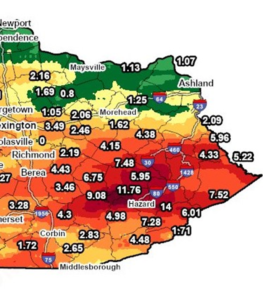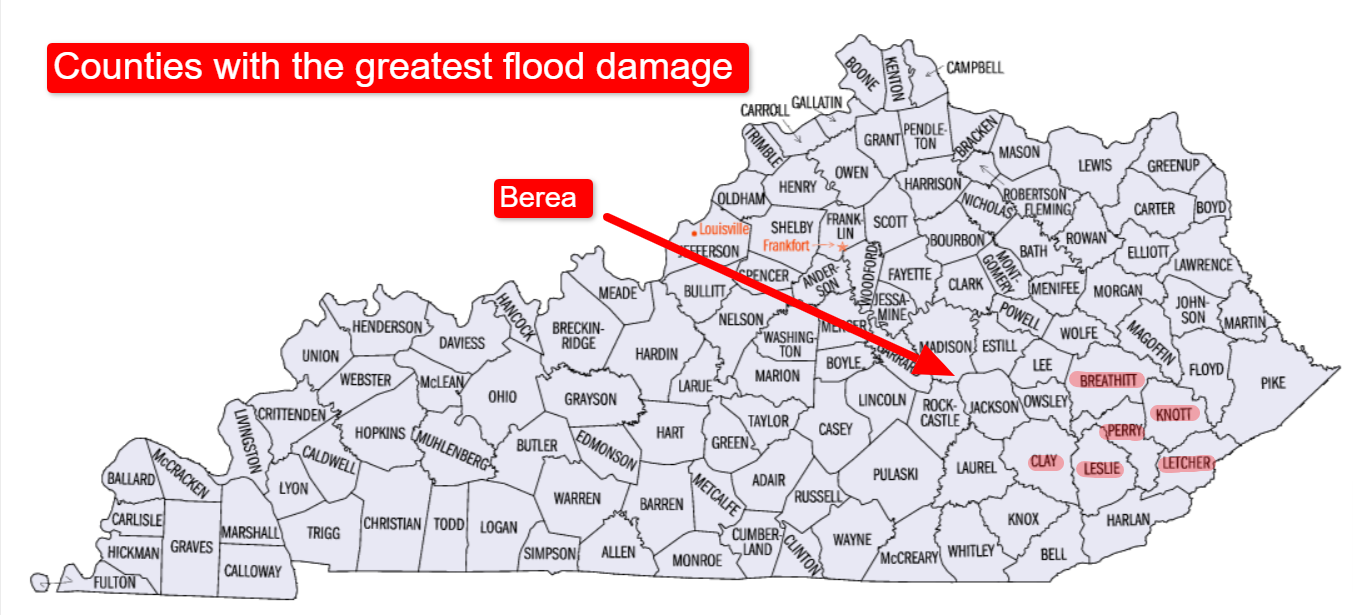Article Written by Lilly Rice

National Weather Service, July 30, 2022
From July 25 through July 30, nine to twelve inches of rain resulted in a record-breaking flood in Breathitt, Letcher, and Knott County. Twelve counties became eligible for FEMA assistance, including Breathitt, Clay, Floyd, Knott, Leslie, Letcher, Magoffin, Martin, Perry, Pike, Owsley, and Whitley Counties. Within these five of those counties, thirty-nine people died, including one during clean-up efforts. As of September 1, according to the Foundation for Appalachian Kentucky, which is based in Perry County, 1,722 homes had been destroyed or lost and 3,986 partial homes damaged.
Flooding in Eastern Kentucky is not a new obstacle for our communities. Annual spring floods are a defining characteristic of the region, bringing destruction and difficulty for development across hundreds of miles. Many of us who call Eastern Kentucky home ask, “Why do these natural disasters keep happening, and how can we better prepare ourselves for the next flooding event?” Although some questions are hard to explain, part of the answer involves how the region’s topography leads to severe flooding.

Although most of Kentucky mountains aren’t incredibly tall, they are intricate and full of communities tucked back into small, steep valleys called “hollows.” These hollers, as local people call them, typically have a water source like a creek or stream, which becomes dangerous during a flash flood. With the summer drought, the record-breaking rain couldn’t absorb the ground fast enough, and basins were overwhelmed. All those streams are tributaries to larger streams, and as those fast-rising streams turned into raging rivers, many people were unable escape. Many communities were swept away by the water or trapped for days. Along with excess water and the oversaturation of the soil, missing trees and compact soil from resource over-extraction of timber and coal caused landslides that destroyed infrastructure vital for these small communities’ function. The combination of environmental factors caused communities and cities to be devastated beyond anything that the region has seen in recent history.

Residents bring supplies into West Perry Elementary School for flood survivors on Friday in Hazard, Ky. Michael Swensen photo from NPR Article
Within days of the devastation, vast resources were being compiled to alleviate the burden of this natural disaster for individual families, non-profits, and small businesses. The quick and compassionate response of the Eastern Kentucky community embodies Appalachian culture. Throughout Appalachia, you’ll find a theme of service to others as a cultural love language. Giving and receiving help is one of the ways that Appalachian communities become intertwined.
Although the flooding didn’t directly impact every Kentucky Appalachian county, a call to action went out across the area to step up and help where able. This eagerness to lend a helping hand quickly caught national attention. The benevolence continued through initiatives such as free farmers’ markets by the LEE initiative based in Louisville, KY, over $2,000,000 of grants distributed within a month of the flooding directly to people affected by the Foundation for Appalachian Kentucky from donors across the nation, and benefit concerts such as Healing to the Holler by Appalachians for Appalachia and Perry County Community Fund to name a few. With people in the region helping everyone they could however they were able, this natural disaster demonstrate the strength and resilience instilled in Appalachian culture.

Photo from the Foundation for Appalachian Kentucky
Local community support wasn’t the only aid that Eastern Kentucky received. Numerous regional, state and national agencies gave (and continue to give) support that will be essential to the recovery of the communities. President Joe Biden and Governor Andy Beshear visited some flooding sites to show their support. The Commonwealth of Kentucky set up the Team Eastern Kentucky Flood Relief Fund in the days following the initial flooding for anyone who wanted to donate to those impacted. As of August 18, the total donated amount was $6,715,099. According to Governor Beshear, all 39 funeral payments have been paid for with a total of $390,000. By August 26, Kentucky lawmakers had passed a $213 million aid package for EKY flooding relief. As of August 26, more than $42 million in grants have been approved under the national FEMA individuals and Households Program for 5,267 households. Applicants have been encouraged to reapply if they don’t receive funds initially, and more grants are expected to be allocated directly to those impacted by the flooding.
Other than the financial assistance, plenty of volunteers across the nation have traveled to EKY to support our communities in their time of need. The overwhelming support of our national community will be remembered by the many Appalachians, including myself, who pride themselves on their Appalachian values of community and benevolence.
Yet much work remains to be done to replace decades of investment in homes, businesses, and infrastructure such as bridges and schools. People in the region will see that work gets done.